RARE! WWII 1945 U. S. Navy LORAN Navigation Map Japan Hiroshima Nagasaki Okinawa
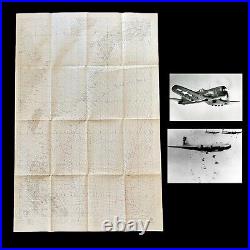

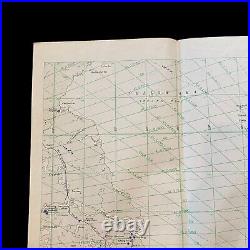
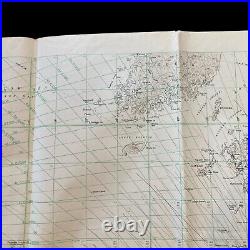
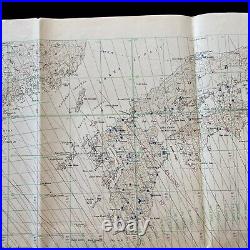
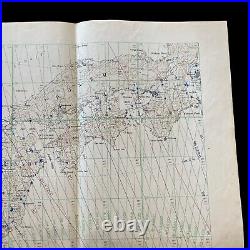
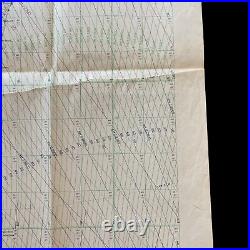
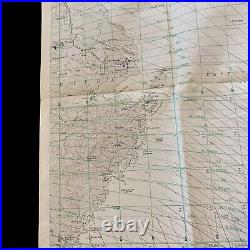
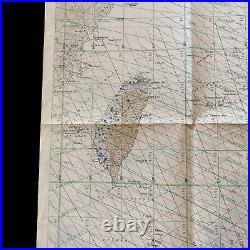
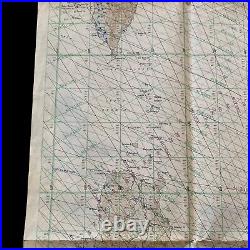
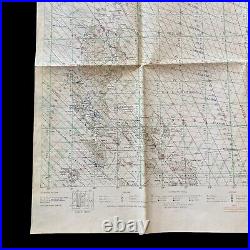
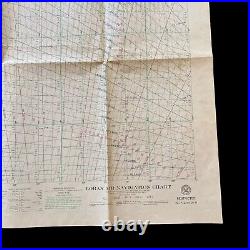
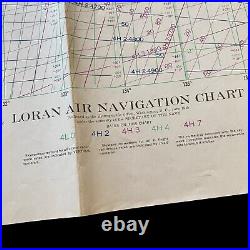
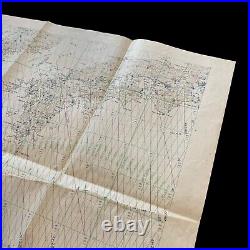
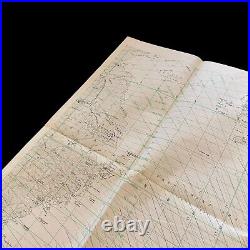
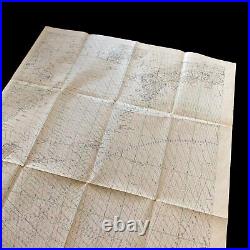

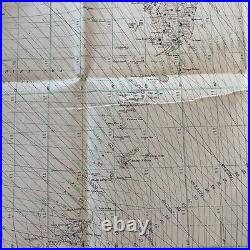
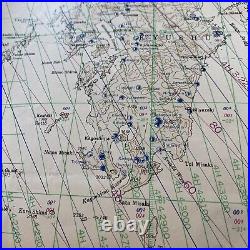
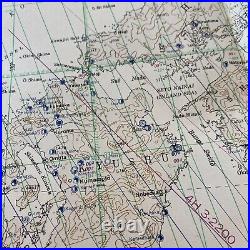
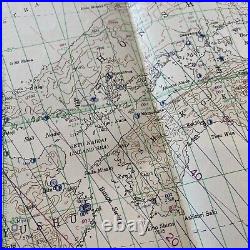
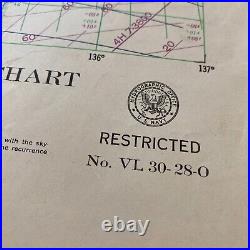
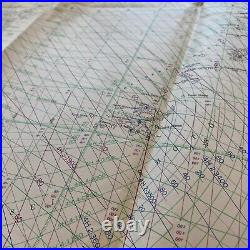
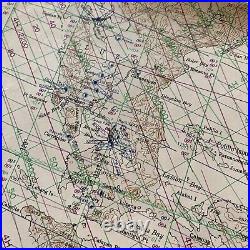

This incredibly rare and museum-grade World War II U. Navy LORAN Air Navigation map is a very rare and scarcely printed navigational chart used in the Pacific Theater.
This very rare FIRST EDITION Pacific Theater plotting chart is dated June 1945 and is extremely detailed with the SECRET LORAN system used for navigating to missions and designated targets throughout the Pacific Theater. This map is marked "RESTRICTED" as this was done a map had very special and classified information. RESTRICTED markings on WWII maps were done when the map was used in combat. This map shows the islands of mainland Japan, Kyushu, Okinawa, Taiwan, Luzon, Mindoro, and the Philippines Islands.This map also shows specialized targets such as Hiroshima and Nagasaki and was printed within months to the dropping of the atomic bomb in August of 1945. The Pacific Theater of World War II was a theatre of war that spanned across the Pacific Ocean and East Asia, including the countries of Japan, China, the Philippines, and others. The theater was a crucial part of the overall war effort, with both the Allies and Axis powers fighting fiercely for control of the region. From June 1945 until the surrender by the Japanese in August of that same year, a series of key events occurred that would ultimately bring an end to the war in the Pacific.
June 1945 marked a critical moment in the Pacific Theater, as the Allies were closing in on Japan's mainland. In the weeks leading up to this time, American forces had conducted a series of brutal battles in the Pacific, including the Battle of Okinawa, which lasted from April to June of that year. The battle was one of the bloodiest of the war, with over 100,000 Japanese soldiers killed and thousands of civilians caught in the crossfire. As the Allies continued to push towards Japan, the Japanese military leadership was divided on how to proceed.Some argued for a surrender, while others believed that Japan could still turn the tide of the war. In early July, the Potsdam Conference began, bringing together the leaders of the Allied powers to discuss the terms of Japan's surrender. The conference ended on August 2nd, with a demand for Japan's immediate and unconditional surrender. Meanwhile, in the Pacific, the Allies were making final preparations for the invasion of Japan's mainland. Known as Operation Downfall, the plan was to launch two separate invasions of Japan's home islands, one in Kyushu and the other in Honshu.
The invasion was expected to be one of the bloodiest of the war, with estimates putting the potential casualty count in the hundreds of thousands. However, on August 6th, the United States dropped an atomic bomb on the Japanese city of Hiroshima, killing over 70,000 people instantly and causing widespread destruction. Three days later, on August 9th, a second atomic bomb was dropped on the city of Nagasaki, killing another 40,000 people. These bombings had a profound impact on Japan's leadership, and on August 10th, Emperor Hirohito announced Japan's surrender. The formal surrender ceremony took place on September 2nd, 1945, aboard the USS Missouri in Tokyo Bay. The ceremony was attended by representatives of the Allied powers, including General Douglas MacArthur, who accepted Japan's unconditional surrender on behalf of the United States.The war in the Pacific was officially over. The events of June to August 1945 in the Pacific Theater were some of the most significant of World War II. The brutal fighting in the Pacific had already taken a toll on both sides, with thousands of lives lost and cities left in ruins. The dropping of the atomic bombs on Hiroshima and Nagasaki, while controversial, ultimately led to Japan's surrender and the end of the war in the Pacific.
The aftermath of the war would have a profound impact on the region, with Japan and other countries undergoing significant reconstruction and changes in government. In conclusion, the events that took place in the Pacific Theater from June 1945 until the surrender by the Japanese in August of that same year were critical in bringing an end to World War II. The brutal fighting in the Pacific had already taken a toll on both sides, and the dropping of the atomic bombs ultimately forced Japan's surrender. While controversial, these bombings are often seen as a necessary step towards ending the war and bringing about peace in the region.
Today, the legacy of the war in the Pacific can still be felt, with many countries in the region continuing to grapple with the aftermath of the conflict. During World War II, navigation was a critical aspect of aerial warfare.
The ability to accurately determine one's position and navigate to a target or return home safely was crucial to the success of missions. One of the most important navigation aids during this period was the LORAN (LOng RAnge Navigation) system.
The LORAN system was first developed in the 1930s by a team of engineers led by Alfred Loomis, who was working for the Radio Corporation of America (RCA). The system worked by sending out a radio signal from two or more transmitters located at known positions on the ground. These signals would be received by an aircraft equipped with a LORAN receiver, which would measure the difference in time between the arrival of the signals.By comparing the time differences, the aircraft could determine its position relative to the known locations of the transmitters. LORAN was superior to other navigation aids available at the time, such as radio direction finding (RDF) and celestial navigation. RDF required the use of a directional antenna and relied on the reception of signals from a single transmitter, making it vulnerable to jamming and interference. Celestial navigation, while accurate, was limited by the need for clear weather and a clear view of the stars.
LORAN, on the other hand, could provide accurate navigation regardless of weather conditions or interference. The system was also difficult to jam, as the signals were transmitted on a low frequency and were spread out over a wide band. This made LORAN a valuable asset for both Allied and Axis forces during World War II.
The use of LORAN was especially important for missions over the Atlantic Ocean, where long distances and poor weather conditions made navigation difficult. The system was also used extensively in the Pacific Theater, where the vast distances and numerous small islands made navigation a challenge. LORAN played a significant role in several important missions during the war. One notable example was the Doolittle Raid on Tokyo in April 1942. The raid, which involved the launch of B-25 bombers from the aircraft carrier USS Hornet, required accurate navigation to reach their targets in Japan and then return to friendly territory in China.
LORAN was instrumental in providing this navigation, allowing the bombers to hit their targets and return safely. Another example of the importance of LORAN was during the Battle of the Atlantic, where the Allies used the system to track German U-boats.
This helped to turn the tide of the battle in the Allies' favor. After the war, LORAN continued to be used for navigation, both by civilian and military aircraft. The system was continually improved, with the development of more accurate transmitters and receivers, and the addition of new features such as Doppler navigation. In conclusion, the LORAN navigation system played a crucial role in aerial navigation during World War II.
Its accuracy and reliability allowed aircraft to navigate accurately over long distances and in poor weather conditions, contributing to the success of numerous missions. The system's continued use after the war demonstrates its value and importance in the history of navigation. This chart shows great theater use for its age and would make an amazing addition to any WWII collection. This item is in the category "Collectibles\Militaria\WW II (1939-45)\Original Period Items\United States\Documents & Maps".The seller is "premierrelics" and is located in this country: US. This item can be shipped worldwide.
- Conflict: WW II (1939-45)
- Original/Reproduction: Original
- Theme: Militaria
- Country/Region of Manufacture: Japan
- Region of Origin: United States
